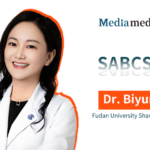
Editor’s Note: The 47th San Antonio Breast Cancer Symposium (SABCS) is in full swing in San Antonio, USA, showcasing cutting-edge research from around the world. On December 12 (Central Time), during the “Poster Spotlight – Session 8: Novel HER2 Therapeutics”, Dr. Biyun Wang and her team from Fudan University Shanghai Cancer Center presented their groundbreaking findings on GQ1005, a highly promising HER2 antibody-drug conjugate (ADC). The study’s evaluation of GQ1005’s efficacy and safety in HER2-positive metastatic breast cancer (MBC) patients drew significant attention, leading to vibrant discussions among experts. Dr. Wang provides an in-depth interpretation of this important research.1
Oncology Frontier: Dr. Wang, could you share the key results of your study on GQ1005 presented at SABCS? What do these findings mean for the treatment of HER2-positive breast cancer?
Dr. Biyun Wang: GQ1005 is an innovative HER2-targeting ADC. This phase Ia/Ib clinical trial aimed to evaluate its safety, tolerability, preliminary efficacy, pharmacokinetics, and immunogenicity in patients with HER2-positive or HER2-mutated advanced solid tumors. In the dose-escalation phase, no dose-limiting toxicities (DLTs) were observed across all five dose levels (2 mg/kg to 8.4 mg/kg), and the recommended phase II dose was determined to be 7.2 mg/kg.
By May 2024, 60 patients with HER2-positive metastatic breast cancer were enrolled in the trial, with 3 patients in the 6.0 mg/kg group and 57 in the 7.2 mg/kg group, including 10 patients with baseline brain metastases. The median number of prior therapies was four (range: 1–11). Of these patients, 93.3% had previously received trastuzumab, 86.7% had been treated with HER2 tyrosine kinase inhibitors (primarily pyrotinib), and 63% had received other HER2 ADCs, such as T-DM1, FS-1502, A166, DX126-262, DP303C, RC48, and TAA013.
At the data cutoff, the objective response rate (ORR) among 49 evaluable patients was 65.3%, with a confirmed ORR of 51%. Seven additional partial responses (PRs) were confirmed during follow-up, bringing the disease control rate (DCR) to 95.9%. After a median follow-up of 4.1 months, the median progression-free survival (mPFS) in the 7.2 mg/kg group was approximately 10.9 months.
In terms of safety, the incidence of treatment-related adverse events (TRAEs) of grade 3 or higher was 8.3%. The most common TRAEs were gastrointestinal toxicity, bone marrow suppression, and liver function abnormalities, most of which were grade 1 or 2. Two cases of grade 1 interstitial lung disease (ILD) were observed, and no patients required dose reductions, discontinued treatment, or died due to adverse events.
In summary, GQ1005 demonstrated promising antitumor activity and an excellent safety profile in heavily pretreated HER2-positive metastatic breast cancer patients, showing great potential for clinical application.
02
Oncology Frontier: What unique structural advantages does GQ1005 offer, and how does it provide better treatment options for patients?
Dr. Biyun Wang: GQ1005 is an innovative HER2-targeting ADC that combines DXd with trastuzumab using a novel enzymatic conjugation technology. Its drug-to-antibody ratio (DAR) is 4. The key advantages of GQ1005 lie in its water solubility, highly stable linker, and the use of the iLDC platform, which ensures higher homogeneity and purity for the ADC.
In the phase I trial, GQ1005 demonstrated robust antitumor activity in HER2-positive advanced breast cancer patients who had undergone extensive prior HER2-targeted treatments. The trial included patients with a median of four prior lines of therapy (range: 1–11), and most patients had received previous pyrotinib treatments, aligning with the characteristics of late-line HER2-positive breast cancer patients in China. Among 49 evaluable patients, GQ1005 achieved an objective response rate (ORR) of 65.3% and a disease control rate (DCR) of 95.9%, showcasing promising antitumor activity.
Although follow-up time was limited, GQ1005 exhibited potential progression-free survival (PFS) and overall survival (OS) benefits. Among the 60 HER2-positive metastatic breast cancer patients treated with GQ1005, the most common treatment-related adverse events (TRAEs) were gastrointestinal toxicity, bone marrow suppression, and liver function abnormalities, primarily grade 1 or 2. Only five patients (8.3%) experienced grade ≥3 TRAEs, and no patients required dose reductions or experienced treatment-related deaths. Serious adverse events (SAEs) related to the drug were minimal, with only one case of anemia reported. Interstitial lung disease (ILD) was observed in two cases, both grade 1, with no grade ≥3 infusion reactions or significant cardiac events reported.
03
Oncology Frontier: Based on the current clinical trial results in HER2-positive breast cancer patients, what are your plans and future research directions for GQ1005? Will larger-scale randomized controlled trials be conducted to validate its efficacy and safety?
Dr. Biyun Wang: GQ1005 has been approved for a phase III clinical trial to treat HER2-positive unresectable or metastatic breast cancer, marking a new phase in its development. This randomized, multicenter phase III trial in China will further evaluate the efficacy and safety of GQ1005.
Future research directions for GQ1005 could follow the path of T-DXd, exploring its use in combination with other therapies to enhance treatment outcomes. Given its excellent safety profile, GQ1005 has the potential for combination treatments that could provide even greater benefits to patients.
In summary, GQ1005 demonstrates tremendous potential in the treatment of HER2-positive breast cancer. Its efficacy is comparable to T-DXd, with an even better safety profile. These promising clinical advancements suggest that GQ1005 may become a new therapeutic option for HER2-positive breast cancer patients.
04
Oncology Frontier: What would you like to say to patients currently battling HER2-positive metastatic breast cancer?
Dr. Biyun Wang: HER2-positive metastatic breast cancer remains a key focus in drug development, and the introduction of multiple HER2-targeted therapies has significantly improved patient outcomes. Treatments such as trastuzumab, pertuzumab, pyrotinib, T-DM1, and T-DXd have offered new hope for these patients.
Even in the face of metastasis, patients should remain optimistic and actively pursue treatment. There are always new, safer, and more effective therapies on the horizon. For patients facing financial challenges, I encourage exploring clinical trials, which can provide access to cutting-edge treatments while contributing to the development of better options for everyone.
Dr. Biyun Wang
- Director, Breast and Genitourinary Oncology Department, Fudan University Shanghai Cancer Center
- Chief Physician and Master’s Supervisor
- Executive Member, Chinese Society of Clinical Oncology (CSCO)
- Chair, CSCO Youth Committee
- Secretary-General, CSCO Patient Education Expert Committee
- Member, CSCO Breast Cancer Expert Committee
- Chair, CRPC Committee, Shanghai Anti-Cancer Association
- Standing Committee Member, Breast Cancer Professional Committee, Shanghai Anti-Cancer Association
Chengcheng Gong
- Medical Oncologist, Fudan University Shanghai Cancer Center
- First author of multiple SCI-indexed publications
- Active participant in numerous national and international conferences
- Principal investigator for four research grants
- Secretary-General, Multidisciplinary Breast Tumor Committee, Shanghai Society of Private Healthcare Institutions


